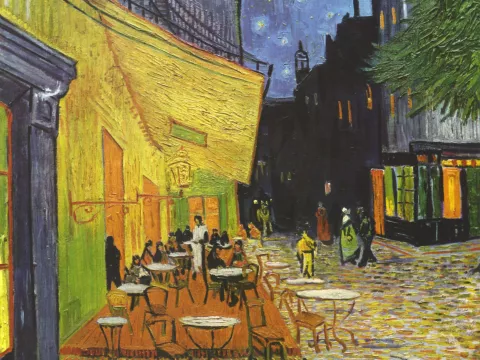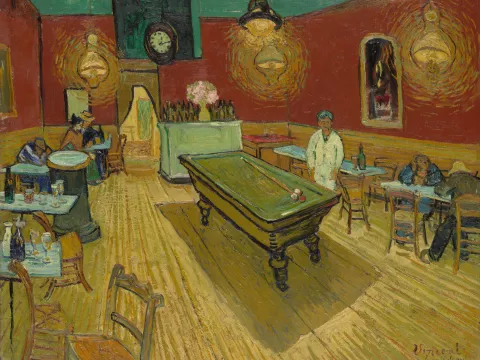Collaboration with Gauguin and the descent into turmoil
In October 1888, Paul Gauguin joined Van Gogh in Arles, responding to his invitation. However, their collaboration proved tumultuous, marked by artistic disagreements and personal tensions. Their cohabitation ended abruptly in December 1888 after a heated argument that led Van Gogh to a tragic act: he cut off part of his ear, a defining event in his life in Arles.
Decline and Legacy
Despite his worsening mental health, Van Gogh continued to paint passionately until his departure for the asylum in Saint-Rémy-de-Provence in May 1889. Though his time in Arles was fraught with suffering, it gave rise to some of the most significant works in the history of art.
Today, the city of Arles celebrates Van Gogh's legacy through iconic sites such as the Langlois Bridge, the Van Gogh Café, and the gardens of the Arles Hospital, all immortalized in his paintings. The Vincent van Gogh Foundation also keeps his memory alive by showcasing works inspired by his genius and hosting contemporary artists.
Van Gogh’s Arles period remains a poignant testament to the creative power and personal struggles of a visionary artist.
Van Gogh's stay in Arles in detail
Van Gogh arrived in Arles on 21 February 1888, and took a room at the Hôtel-Restaurant Carrel. He moved to the town with ideas of founding a utopian art colony, and the Danish artist Christian Mourier-Petersen became his companion for two months. That March, Van Gogh painted local landscapes using a gridded "perspective frame." Three of these paintings were shown at the annual exhibition of the Société des Artistes Indépendants. That April, he was visited by the American artist Dodge MacKnight who was resident nearby at Fontvieille.
On 1 May, he signed a lease for 15 francs a month to rent four rooms in the eastern wing of the Yellow House at No. 2 Place Lamartine. The house was unfurnished and had been uninhabited for some time so he was not able to move in straight away. He had been staying at the Hôtel Restaurant Carrel, but the rate charged by the hotel was 5 francs a week, which Van Gogh found excessive. He disputed the price, and took the case to the local arbitrator who awarded him a twelve franc reduction on his total bill.
On 7 May, he moved out of the Hôtel Carrel and into the Café de la Gare. He became friends with the proprietors, Joseph and Marie Ginoux. Although the Yellow House had to be furnished before he could fully move in, Van Gogh was able to use it as a studio. Hoping to also have a gallery for his work, his major project at this time was a series of paintings which included: Van Gogh's Chair 1888, Van Gogh Bedroom in Arles (1888), The Night Café (1888), The Café Terrace on the Place du Forum, Arles, at Night September 1888, Starry Night Over the Rhone (1888), Still Life: Vase with Twelve Sunflowers 1888, all intended to form the décoration for the Yellow House. Van Gogh wrote about The Night Café: I have tried to express the idea that the café is a place where one can ruin oneself, go mad, or commit a crime.
About "Bedroom in Arles". A series of three iconic paintings created between 1888 and 1889. They depict his bedroom in the Yellow House in Arles, with vibrant colors and distorted perspectives that evoke a sense of intimacy and tranquility. Van Gogh considered these works among his most personal and sought to express his ideal of simplicity and restfulness through them.
In June, he visited Saintes-Maries-de-la-Mer. He gave drawing lessons to a Zouave second lieutenant, Paul-Eugène Milliet, who became a companion. MacKnight introduced him to Eugène Boch, a Belgian painter who stayed at times in Fontvieille, and the two artists exchanged visits in July.
Gauguin agreed to join him in Arles. That August, Van Gogh painted sunflowers; Boch visited again and Van Gogh painted his portrait as well as the study The Poet Against a Starry Sky. Boch's sister Anna, also an artist, purchased The Red Vineyard in 1890. On 8 September, upon advice from his friend the station's postal supervisor, Joseph Roulin, whose portrait he painted, he bought two beds, and he finally spent the first night in the still sparsely furnished Yellow House on 17 September. When Gauguin consented to work and live in Arles side-by-side with Van Gogh, he started to work on the The Décoration for the Yellow House, probably the most ambitious effort he ever undertook. Van Gogh did two chair paintings: Van Gogh's Chair and Gauguin's Chair.
After repeated requests from Van Gogh, Gauguin arrived in Arles on 23 October. During November, they painted together. Gauguin painted Van Gogh's portrait The Painter of Sunflowers: Portrait of Vincent van Gogh, and uncharacteristically, Van Gogh painted some pictures from memory, deferring to Gauguin's ideas in this. Their first joint outdoor painting exercise was conducted at the picturesque Alyscamps. In November Van Gogh painted The Red Vineyard.
In December, the two artists visited Montpellier and viewed works in the Alfred Bruyas collection by Courbet and Delacroix in the Musée Fabre. However, their relationship was deteriorating badly. They quarreled fiercely about art. Van Gogh felt an increasing fear that Gauguin was going to desert him, and what he described as a situation of "excessive tension" reached a crisis point.
On 23 December 1888,Van Gogh stalked Gauguin with a razor and then later cut off the lower part of his own left ear lobe, which he wrapped in newspaper and gave to a prostitute named Rachel in the local brothel, asking her to "keep this object carefully."
Gauguin left Arles and never saw Van Gogh again. However, they continued to correspond and in 1890 Gauguin proposed they form an artist studio in Antwerp. Around this time, Van Gogh was hospitalized and he was in a critical state for several days. Immediately, Theo (whom Gauguin had notified) visited, as did Madame Ginoux and Roulin. He continued to ask for Gauguin and told Theo that he "thought about him all the time."
In January 1889, Van Gogh returned to the Yellow House, but he spent the following month between hospital and home suffering from hallucinations and paranoia that he was being poisoned. In March, the police closed his house, after a petition by 30 townspeople, who called him "fou roux" (the redheaded madman). Paul Signac visited him in hospital and Van Gogh was allowed home in his company. In April, he moved into rooms owned by Dr. Rey, after floods damaged paintings in his own home.
Then Vincent van Gogh left Arles to Saint-Rémy-de-Provence…
Visit The Vincent van Gogh Foundation Arles
More on Vincent van Gogh Arles






